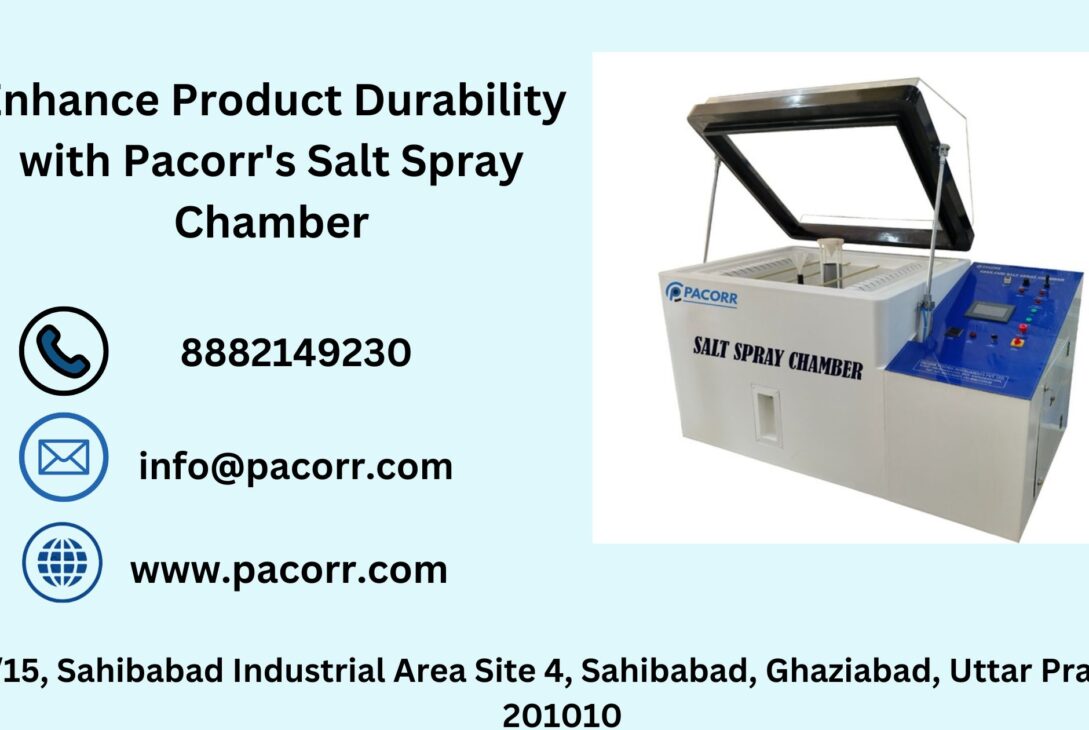Introduction
In today’s highly competitive manufacturing landscape, maintaining the quality and durability of products is paramount. Corrosion is a significant issue, especially for metals exposed to harsh environments. The Salt Spray Chamber by Pacorr is a sophisticated solution designed to simulate corrosion conditions, helping manufacturers ensure the long-term resilience of their products. This article explores the importance, functionality, and benefits of the Salt Spray Chamber in industrial testing processes.
What is a Salt Spray Chamber?
Do you want to visit Haridwar? travel agents in Haridwar is the right place to plan your tour. You can book your tour from here.
A Salt Spray Chamber Price also known as a corrosion testing chamber, is a specialized testing instrument that accelerates the process of rust formation to evaluate a material’s or coating’s corrosion resistance. It is widely used in industries like automotive, aerospace, construction, and marine, where metal components are prone to corrosion. The Salt Spray Chamber from pacorr.com ensures that products meet industry standards and can withstand rigorous environmental conditions.
How Does the Salt Spray Chamber Work?
The chamber works by creating a controlled environment that simulates corrosion. A saltwater solution is atomized and sprayed within the chamber, covering the product or sample uniformly. This continuous exposure to salt spray accelerates the corrosion process, allowing manufacturers to observe the product’s resilience over a condensed period.
Do you want to visit char dham? char dham tour operator is the right place to plan you Char Dham tour. You can book you tour from here.
Key Features of Pacorr’s Salt Spray Chamber:
- Advanced Temperature Control: Pacorr’s chamber allows precise control over temperature, crucial for simulating realistic corrosion conditions.
- Uniform Salt Solution Distribution: A specialized nozzle ensures even distribution, preventing uneven corrosion patterns.
- User-Friendly Interface: The chamber is designed with a simple, intuitive interface, making it easy to set parameters and monitor tests.
- Comprehensive Test Standards Compliance: Pacorr’s Salt Spray Chamber is designed to comply with standards such as ASTM B117, ISO 9227, and other international corrosion testing requirements.
Why Use Pacorr’s Salt Spray Chamber?
Using the Salt Spray Test Chamber allows manufacturers to detect potential vulnerabilities in products, coatings, and materials. This test is particularly beneficial for products that need a long service life and are subject to environmental exposure, such as fasteners, automotive parts, and construction materials.
Benefits of Salt Spray Testing
- Improved Product Reliability: By identifying corrosion-prone areas, manufacturers can enhance product design and material choice.
- Cost-Efficiency: Early detection of corrosion issues prevents costly product recalls and customer dissatisfaction.
- Compliance Assurance: Using a reliable Salt Spray Chamber from pacorr.com ensures that products meet international quality and durability standards.
- Reduced R&D Time: With accelerated testing, manufacturers can make swift decisions in product development, reducing time to market.
Industries That Benefit from Salt Spray Testing
Several industries can benefit from incorporating salt spray testing into their quality control processes:
Do you want to visit Indiar? tour operator in India is the right place to plan your tour. You can book your tour from here.
- Automotive: Ensures the longevity of metal parts and coatings, especially those used in vehicle exteriors.
- Construction: Validates the durability of metal reinforcements, tools, and fixtures that face outdoor exposure.
- Marine: Marine products are constantly exposed to saltwater, making salt spray testing essential for assessing durability.
- Electronics: For components used in harsh environments, this test helps assess and improve protective coatings.
How to Conduct a Salt Spray Test with Pacorr’s Chamber
- Prepare the Sample: Clean and prepare the test sample to ensure accurate results.
- Set Testing Parameters: Adjust settings based on test requirements, including salt concentration, temperature, and duration.
- Conduct the Test: The chamber will simulate corrosive conditions over hours or days, depending on the test parameters.
- Analyze Results: After the test, analyze the level of corrosion to evaluate the sample’s performance.
Conclusion
Investing in Pacorr’s Salt Spray Test Chamber Price empowers manufacturers to deliver reliable, corrosion-resistant products that stand up to challenging environments. By proactively testing for corrosion, companies can maintain high product standards, increase customer satisfaction, and ensure compliance with global industry standards. Visit pacorr.com to explore more about the Salt Spray Chamber and elevate your quality testing practices.
Salt Spray Chamber FAQ
1. What is the purpose of a Salt Spray Chamber?
The Salt Spray Chamber is used to simulate corrosive environments, accelerating the corrosion process on metal and coated surfaces. It helps manufacturers assess the corrosion resistance of products, materials, and coatings, ensuring they meet industry standards for durability and quality.
2. How does a Salt Spray Chamber work?
The chamber creates a controlled environment by atomizing a saltwater solution, which is continuously sprayed over the test sample. This setup replicates harsh conditions, enabling accelerated corrosion testing. The temperature, concentration, and duration can be adjusted based on specific testing standards.
3. What types of industries benefit from salt spray testing?
Salt spray testing is beneficial for industries like automotive, aerospace, construction, marine, and electronics, where metal components and coatings are exposed to corrosive environments. It’s especially useful for products that need long-term durability and environmental resistance.
4. What standards does Pacorr’s Salt Spray Chamber meet?
Pacorr’s Salt Spray Chamber Price complies with global standards such as ASTM B117, ISO 9227, and other corrosion testing standards. These standards ensure that the testing process is accurate and aligns with international quality expectations.
5. How long does a salt spray test take?
The test duration depends on the material and the desired corrosion resistance level. Standard tests can last anywhere from a few hours to several days. Longer tests simulate prolonged exposure and provide insights into a product’s long-term durability.
6. Can I test non-metallic materials in a Salt Spray Chamber?
Yes, non-metallic materials with specific coatings or finishes can also be tested. However, the chamber is primarily used for metallic components and coatings that require evaluation in corrosive conditions.
7. What kind of maintenance does the Salt Spray Chamber require?
Regular maintenance includes cleaning the chamber, checking and refilling the salt solution, and ensuring the nozzle and other components function properly. Following a routine maintenance schedule will extend the life of the chamber and ensure accurate test results.
8. How is the salt solution concentration determined?
The salt concentration typically follows the standard requirements, such as 5% NaCl solution for ASTM B117. Adjustments can be made based on the specific test or industry standards required.
9. What is the impact of temperature on salt spray testing?
Temperature plays a crucial role in corrosion rates. Higher temperatures accelerate corrosion, which can reveal weaknesses faster. Pacorr’s Salt Spray Chamber allows precise temperature control for customizable test conditions.
10. Can salt spray testing predict real-life corrosion?
While salt spray testing accelerates corrosion, it does not replicate every real-life condition exactly. However, it provides a strong indication of a material’s resilience in corrosive environments and helps manufacturers improve product durability.
11. Is salt spray testing the same as humidity testing?
No, salt spray testing Price specifically focuses on salt corrosion, while humidity testing assesses how materials withstand moist environments without salt exposure. Both tests are valuable for understanding different aspects of material durability.
12. Can I customize the testing conditions in Pacorr’s Salt Spray Chamber?
Yes, Pacorr’s Salt Spray Chamber allows customization for temperature, salt concentration, and exposure duration, making it flexible for different testing standards and requirements.
13. How does salt spray testing benefit manufacturers?
Salt spray testing helps manufacturers identify and address potential corrosion issues, improving product quality and reliability. It also assists in meeting regulatory requirements and enhancing customer satisfaction by delivering corrosion-resistant products.
14. What factors affect the accuracy of salt spray test results?
Factors like temperature control, salt solution concentration, nozzle function, and chamber cleanliness affect test accuracy. Regular maintenance and calibration of the chamber ensure consistent and reliable results.



